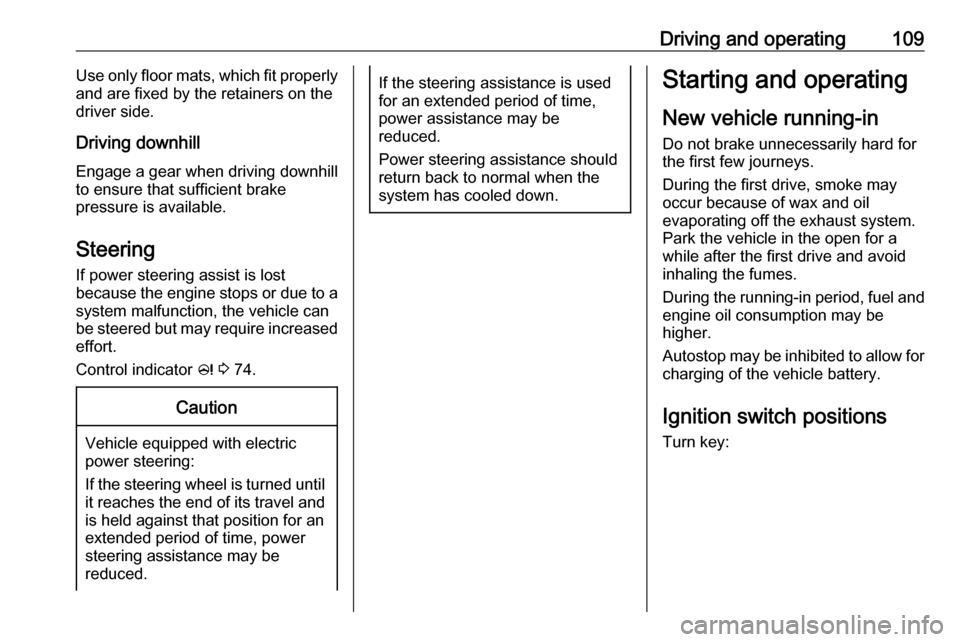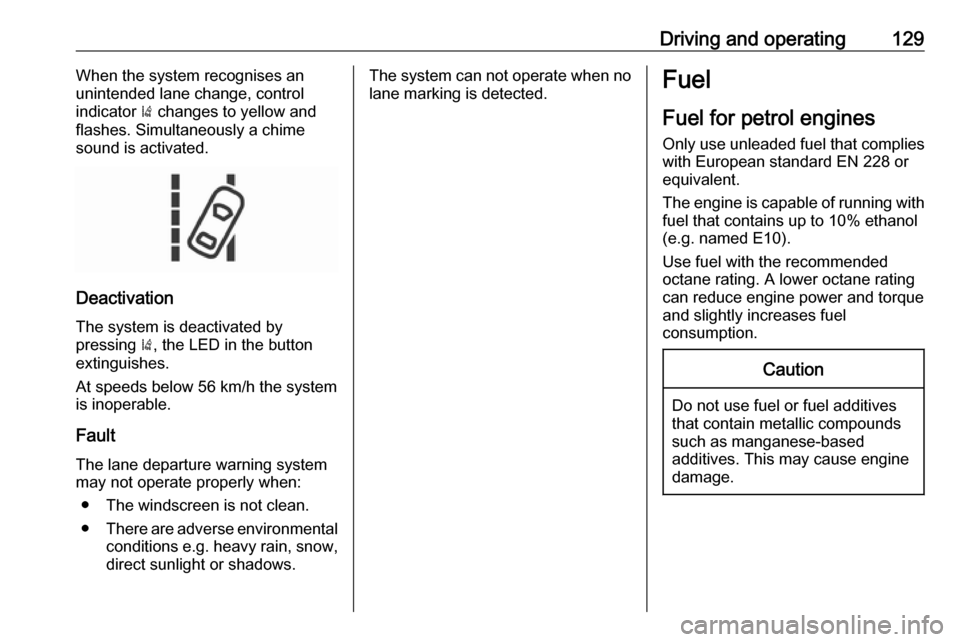fuel consumption OPEL KARL 2017.5 Manual user
[x] Cancel search | Manufacturer: OPEL, Model Year: 2017.5, Model line: KARL, Model: OPEL KARL 2017.5Pages: 203, PDF Size: 5.4 MB
Page 81 of 203

Instruments and controls79Fuel range
Range is calculated from current fuel
tank level and current consumption.
The display shows average values.
After refuelling, the range is updated
automatically after a brief delay.
When the fuel level in the tank is low,
a message appears on the display
and control indicator Y in the fuel
gauge illuminates.
When the tank must be refuelled
immediately, a warning code appears and remains on the display.
Additionally, control indicator Y
flashes in the fuel gauge 3 76.
Fuel range, LPG version
Display of the approximate total fuel
range for both fuel tanks (LPG and
petrol).
Average vehicle speed
Display of average speed. The
measurement can be reset at any
time.
To reset, press SET/CLR for a few
seconds while viewing this page.
Instantaneous fuel economy
Display of the instantaneous
consumption.
On vehicles with LPG engines:
Instantaneous consumption is
indicated for the currently selected mode, LPG or petrol.
Page 82 of 203

80Instruments and controlsAverage fuel economy
Display of average consumption. Themeasurement can be reset at any
time and starts with a default value.
To reset, press SET/CLR for a few
seconds while viewing this page.
On vehicles with LPG engines:
Average consumption is indicated for
the currently selected mode, LPG or
petrol.
Timer
Indicates driving time since last reset.
To stop or start timer press
SET/CLR .
To reset press and hold SET/CLR for
a few seconds.
Vehicle information
Possible pages are: ● unit
● remaining engine oil life indication
● tyre pressure
● tyre loading
Unit
Press SET/CLR while page is
displayed. Select metric (unit 1) or
imperial (unit 2) by turning the
adjuster wheel. Press SET/CLR to set
the unit of measurement.
Page 110 of 203

108Driving and operatingDriving and
operatingDriving hints ............................... 108
Control of the vehicle ...............108
Steering ................................... 109
Starting and operating ...............109
New vehicle running-in ............109
Ignition switch positions ...........109
Retained power off ..................110
Starting the engine ..................110
Overrun cut-off ........................ 111
Stop-start system ....................111
Parking .................................... 114
Engine exhaust .......................... 115
Catalytic converter ...................115
Manual transmission ..................115
Manual transmission automa‐ ted .............................................. 116
Transmission display ...............116
Starting the engine ..................116
Selector lever .......................... 117
Manual mode ........................... 118
Electronic driving programmes 118
Fault ........................................ 118Brakes........................................ 119
Antilock brake system .............119
Parking brake .......................... 120
Brake assist ............................. 120
Hill start assist ......................... 120
Ride control systems .................121
Traction Control system ..........121
Electronic Stability Control ......122
City mode ................................ 123
Driver assistance systems .........124
Cruise control .......................... 124
Speed limiter ........................... 125
Parking assist .......................... 127
Lane departure warning ..........128
Fuel ............................................ 129
Fuel for petrol engines .............129
Fuel for liquid gas operation ....130
Refuelling ................................ 132
Fuel consumption - CO 2-
Emissions ............................... 136Driving hints
Control of the vehicle
Never coast with engine not
running
Many systems will not function in this situation (e.g. brake servo unit, power
steering). Driving in this manner is a
danger to yourself and others.
All systems function during an
Autostop.
Stop-start system 3 111.
Idle boost
If charging of the vehicle battery is
required due to battery condition, the
power output of the generator must be increased. This will be achieved by an idle boost which may be audible.
A message appears in the Driver
Information Centre.
Pedals
To ensure the pedal travel is
uninhibited, there must be no mats in
the area of the pedals.
Page 111 of 203

Driving and operating109Use only floor mats, which fit properly
and are fixed by the retainers on the
driver side.
Driving downhill
Engage a gear when driving downhill
to ensure that sufficient brake
pressure is available.
Steering If power steering assist is lost
because the engine stops or due to a
system malfunction, the vehicle can
be steered but may require increased
effort.
Control indicator c 3 74.Caution
Vehicle equipped with electric
power steering:
If the steering wheel is turned until it reaches the end of its travel and
is held against that position for an
extended period of time, power
steering assistance may be
reduced.
If the steering assistance is used
for an extended period of time,
power assistance may be
reduced.
Power steering assistance should
return back to normal when the
system has cooled down.Starting and operating
New vehicle running-in Do not brake unnecessarily hard for
the first few journeys.
During the first drive, smoke may
occur because of wax and oil
evaporating off the exhaust system.
Park the vehicle in the open for a
while after the first drive and avoid
inhaling the fumes.
During the running-in period, fuel and engine oil consumption may be
higher.
Autostop may be inhibited to allow for
charging of the vehicle battery.
Ignition switch positions
Turn key:
Page 131 of 203

Driving and operating129When the system recognises an
unintended lane change, control
indicator ) changes to yellow and
flashes. Simultaneously a chime
sound is activated.
Deactivation
The system is deactivated by
pressing ), the LED in the button
extinguishes.
At speeds below 56 km/h the system
is inoperable.
Fault
The lane departure warning system may not operate properly when:
● The windscreen is not clean.
● There are adverse environmental
conditions e.g. heavy rain, snow,
direct sunlight or shadows.
The system can not operate when no lane marking is detected.Fuel
Fuel for petrol engines
Only use unleaded fuel that complies
with European standard EN 228 or
equivalent.
The engine is capable of running with fuel that contains up to 10% ethanol
(e.g. named E10).
Use fuel with the recommended
octane rating. A lower octane rating
can reduce engine power and torque
and slightly increases fuel
consumption.Caution
Do not use fuel or fuel additives
that contain metallic compounds
such as manganese-based
additives. This may cause engine
damage.
Page 138 of 203

136Driving and operating
DISH adapter: Austria, Bosnia-
Herzegovina, Bulgaria, Croatia,
Czech Republic, Denmark, Estonia,
France, Greece, Hungary, Italy,
Latvia, Lithuania, Macedonia,
Poland, Portugal, Romania, Serbia,
Slovakia, Slovenia, Sweden,
Switzerland, Turkey, Ukraine
Fuel filler cap
Only use genuine fuel filler caps.
Fuel consumption - CO 2-
Emissions
The fuel consumption (combined) of
the model Opel Karl is within a range
of 4.6 to 4.1 l/100 km.
Depending on country, the fuel
consumption is displayed in km/l. In
this case the fuel consumption
(combined) of the model Opel Karl is
within a range of 21,7 to 24.3 km/l.
The CO 2 emission (combined) is
within a range of 106 to 94 g/km.
For the values specific for your
vehicle, refer to the EEC Certificate of
Conformity provided with your vehicle
or other national registration
documents.
General information The official fuel consumption and
specific CO 2 emission figures quoted
relate to the EU base model with standard equipment.
Fuel consumption data and CO 2
emission data are determined
according to regulation R (EC)
No. 715/2007 (in the latest applicableversion), taking into consideration the
vehicle weight in running order, as
specified by the regulation.
The figures are provided only for the
purpose of comparison between
different vehicle variants and must
not be taken as a guarantee for the
actual fuel consumption of a
particular vehicle. Additional
equipment may result in slightly
higher results than the stated
consumption and CO 2 figures.
Furthermore, fuel consumption is
dependent on personal driving style as well as road and traffic conditions.
Page 139 of 203

Vehicle care137Vehicle careGeneral Information...................137
Accessories and vehicle modifications .......................... 137
Vehicle storage ........................138
End-of-life vehicle recovery .....138
Vehicle checks ........................... 139
Performing work ......................139
Bonnet ..................................... 139
Engine oil ................................. 140
Engine coolant ......................... 141
Washer fluid ............................ 142
Brakes ..................................... 142
Brake fluid ............................... 142
Vehicle battery ......................... 142
Wiper blade replacement ........144
Bulb replacement .......................145
Halogen headlights ..................145
Fog lights ................................. 147
Front turn signal lights .............147
Tail lights ................................. 148
Side turn signal lights ..............149
Centre high-mounted brake light ......................................... 149
Number plate light ...................150Interior lights ............................ 150
Instrument panel illumination ...150
Electrical system ........................151
Fuses ....................................... 151
Engine compartment fuse box . 152
Instrument panel fuse box .......154
Vehicle tools .............................. 155
Tools ........................................ 155
Wheels and tyres .......................156
Winter tyres ............................. 156
Tyre designations ....................156
Tyre pressure .......................... 157
Tyre pressure monitoring
system .................................... 158
Tread depth ............................. 161
Changing tyre and wheel size . 161 Wheel covers ........................... 162
Tyre chains .............................. 162
Tyre repair kit .......................... 162
Wheel changing .......................165
Spare wheel ............................ 168
Jump starting ............................. 170
Towing ....................................... 171
Towing the vehicle ...................171
Appearance care .......................172
Exterior care ............................ 172
Interior care ............................. 174General Information
Accessories and vehiclemodifications
We recommend the use of genuine
parts and accessories and factory approved parts specific for your
vehicle type. We cannot assess or
guarantee reliability of other products
- even if they have a regulatory or
otherwise granted approval.
Any modification, conversion or other changes made to standard vehicle
specifications (including, without
limitation, software modifications,
modifications of the electronic control
units) may invalidate the warranty
offered by Opel. Furthermore, such
changes may affect driver assistance
systems, may impact fuel
consumption, CO 2 emissions and
other emissions of the vehicle and
cause the vehicle to no longer
conform to the type approval,
impacting the validity of your vehicle
registration.
Page 159 of 203

Vehicle care157Directional tyresDirectional tyres must be mounted so
that they rotate in the correct
direction. The proper rotation
direction is indicated by a symbol
(e.g. an arrow) on the sidewall.
Tyre pressure
Check the pressure of cold tyres at least every 14 days and before any
long journey.
Do not forget the spare wheel.
This also applies to vehicles with tyre pressure monitoring system.
Unscrew the valve cap.Tyre pressure 3 189.
The tyre pressure information label
on the driver's door frame indicates
the original equipment tyres and the
correspondent tyre pressures.
The tyre pressure data refers to cold
tyres. It applies to summer and winter tyres.
The ECO tyre pressure serves to
achieve the smallest amount of fuel
consumption possible.
Incorrect tyre pressures will impair
safety, vehicle handling, comfort and fuel economy and will increase tyre
wear.
Tyre pressures differ depending on
various options.
For the correct tyre pressure value,
follow the procedure below:
● Identify the engine identifier code. Engine data 3 184.
● Identify the respective tyre.
For the tyres approved for your
vehicle, refer to the EEC Certificate of
Conformity provided with your vehicle or other national registration
documents.The driver is responsible for correct adjustment of tyre pressure.9 Warning
If the pressure is too low, this can
result in considerable tyre warm-
up and internal damage, leading to tread separation and even to tyre
blow-out at high speeds.
9 Warning
For specific tyres the
recommended tyre pressure as
shown in the tyre pressure table may exceed the maximum tyre
pressure as indicated on the tyre.
Never exceed the maximum tyre
pressure as indicated on the tyre.
If the tyre pressure must be reduced
or increased, switch off ignition. After
adjusting tyre pressure switch on
ignition and select the relevant setting on the page Tyre Load in the Driver
Information Centre 3 77.
Page 199 of 203

197Cupholders .................................. 53
Curtain airbag system .................. 45
D
Danger, Warnings and Cautions ...4
Daytime running lights .................94
Declaration of conformity ............190
Door open .................................... 77
Doors ............................................ 26
Driver assistance systems ..........124
Driver Information Centre .............77
Driving hints ................................ 108
E Electric adjustment ......................29
Electrical system......................... 151
Electronic climate control system 102
Electronic driving programmes ..118
Electronic Stability Control.......... 122
Electronic Stability Control and Traction Control system ............74
Electronic Stability Control off....... 74
End-of-life vehicle recovery .......138
Engine compartment fuse box ...152
Engine coolant ........................... 141
Engine coolant temperature ........75
Engine coolant temperature gauge ....................................... 68
Engine data ............................... 184
Engine exhaust .......................... 115
Engine identification ...................180Engine oil ................... 140, 177, 181
Engine oil pressure ......................75
Event data recorders ..................194
Exit lighting .................................. 97
Exterior care .............................. 172
Exterior light ................................. 76
Exterior lighting ......................14, 93
Exterior mirrors ............................. 29
F Fault ........................................... 118
First aid ......................................... 58
First aid kit ................................... 58
Fixed air vents ........................... 106
Fog light ....................................... 76
Fog lights ................................... 147
Folding mirrors ............................. 29
Front airbag system .....................44
Front doors ................................... 26
Front fog lights ............................. 95
Front seats.................................... 36
Front turn signal lights ...............147
Fuel............................................. 129
Fuel consumption - CO 2-
Emissions ............................... 136
Fuel for liquid gas operation .......130
Fuel for petrol engines ...............129
Fuel gauge ................................... 66 Fuel selector ................................ 67
Fuses ......................................... 151G
Gauges ......................................... 65
Gear shifting ................................. 74
Glovebox ..................................... 53
H
Halogen headlights ....................145
Hand brake ......................... 119, 120
Hazard warning flashers ..............94
Headlight flash ............................. 93
Headlight range adjustment ........94
Headlights..................................... 93
Headlights when driving abroad ..94
Head restraint adjustment .............8
Head restraints ............................ 35
Heated mirrors ............................. 30
Heated rear window ..................... 33
Heated steering wheel .................61
Heating ........................................ 38
Heating and ventilation system ...99
High beam ............................. 76, 93
Hill start assist ........................... 120
Horn ....................................... 15, 62
I
Identification plate .....................180
Ignition switch positions .............109
Immobiliser ............................ 28, 76
Indicators ...................................... 65
Info display ................................... 82
Information displays...................... 77